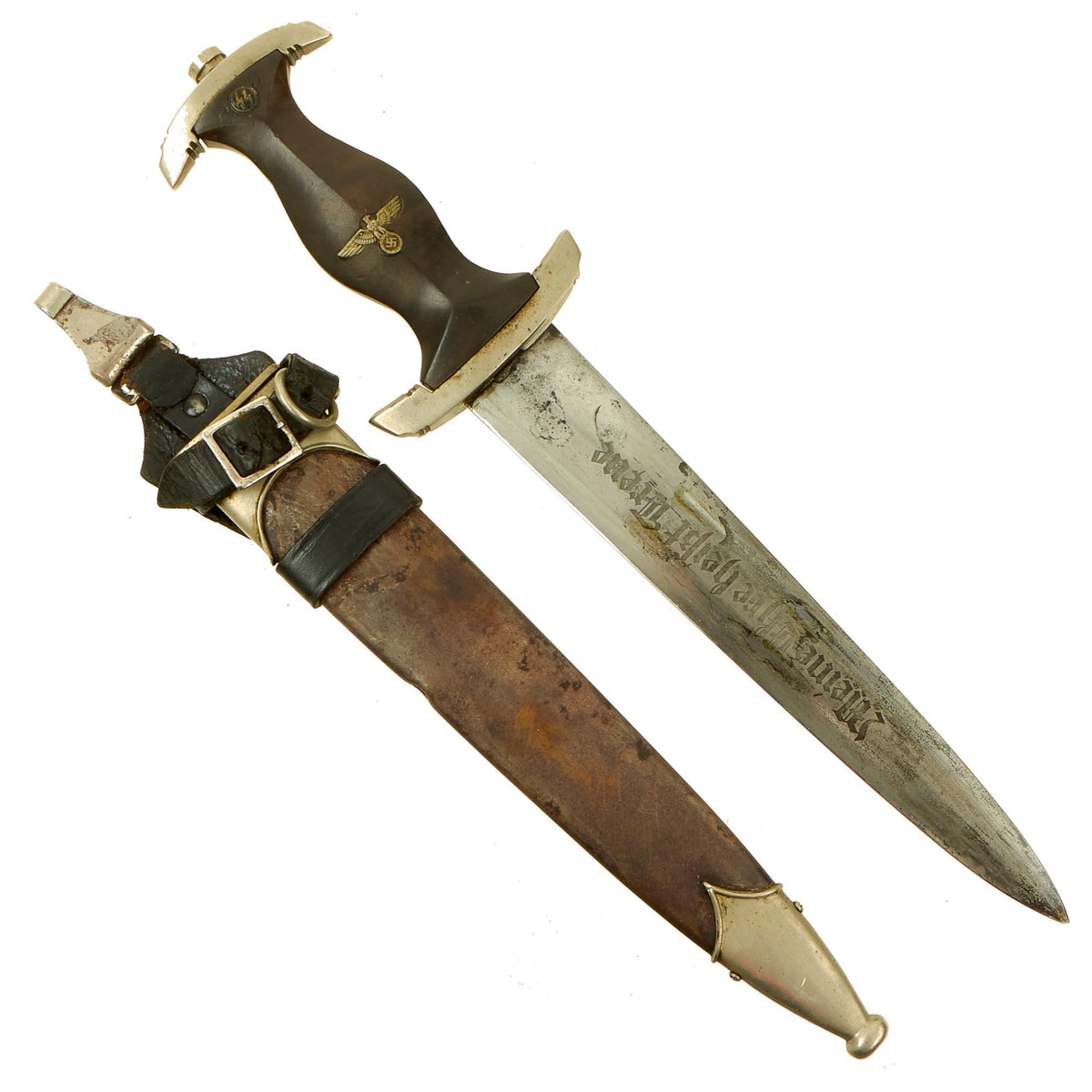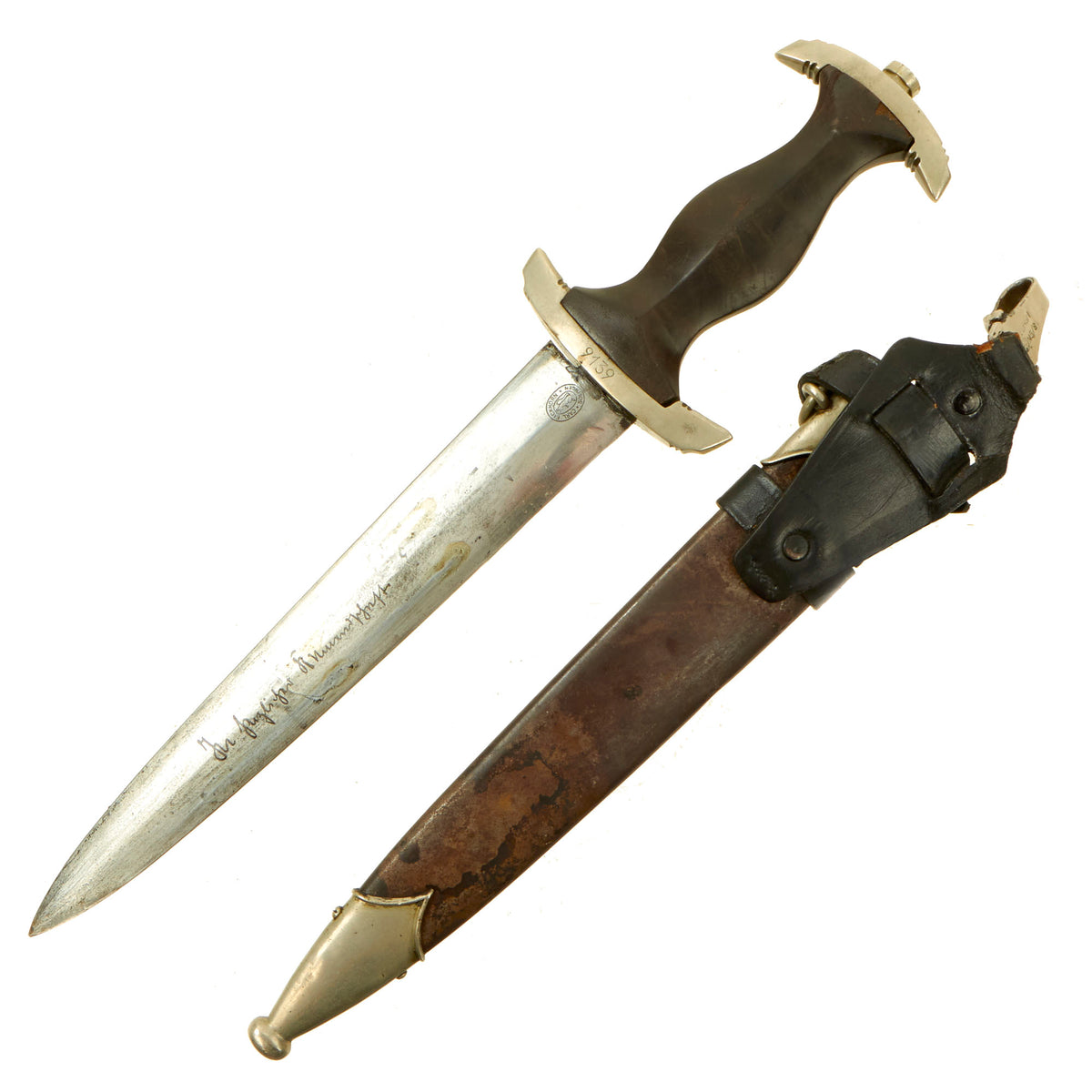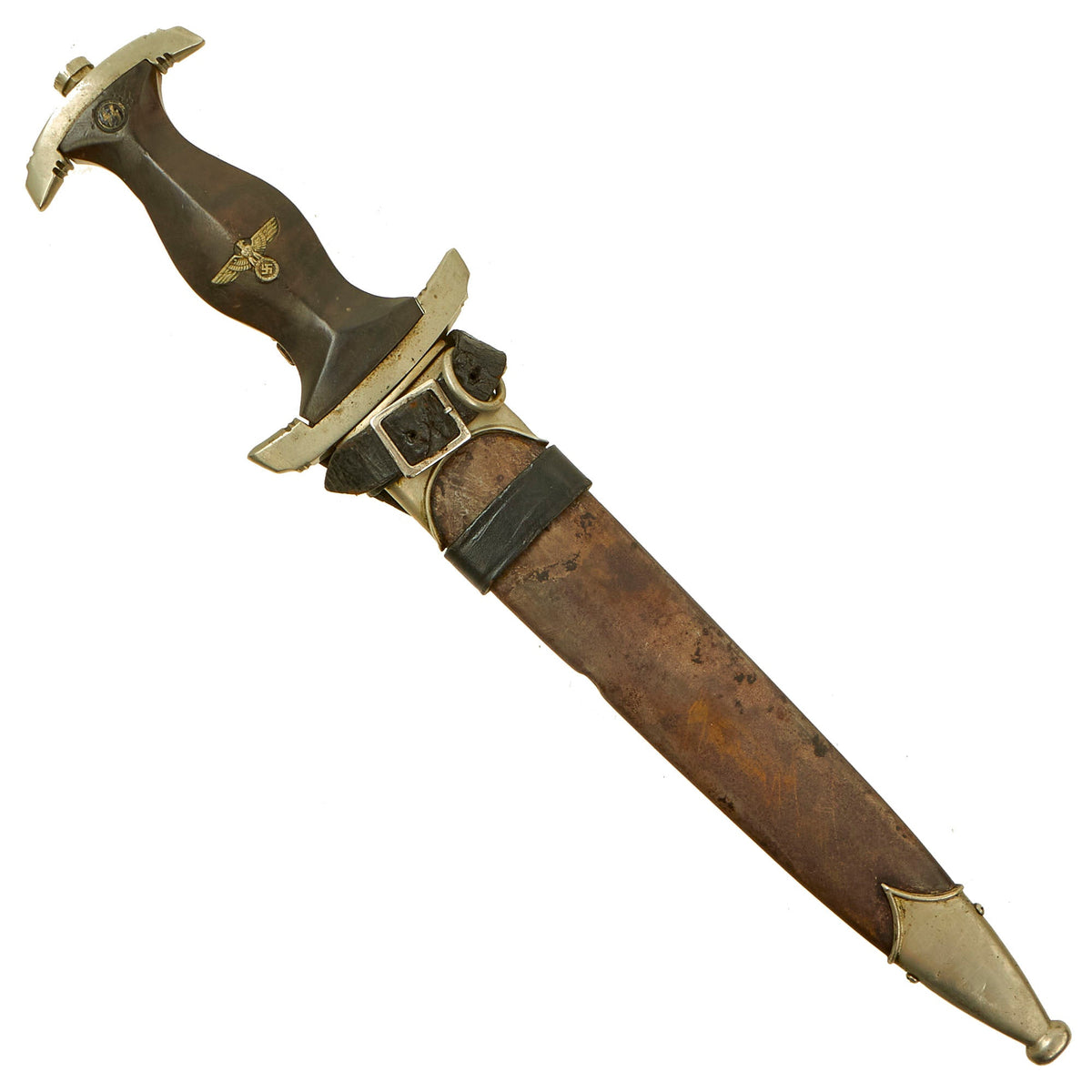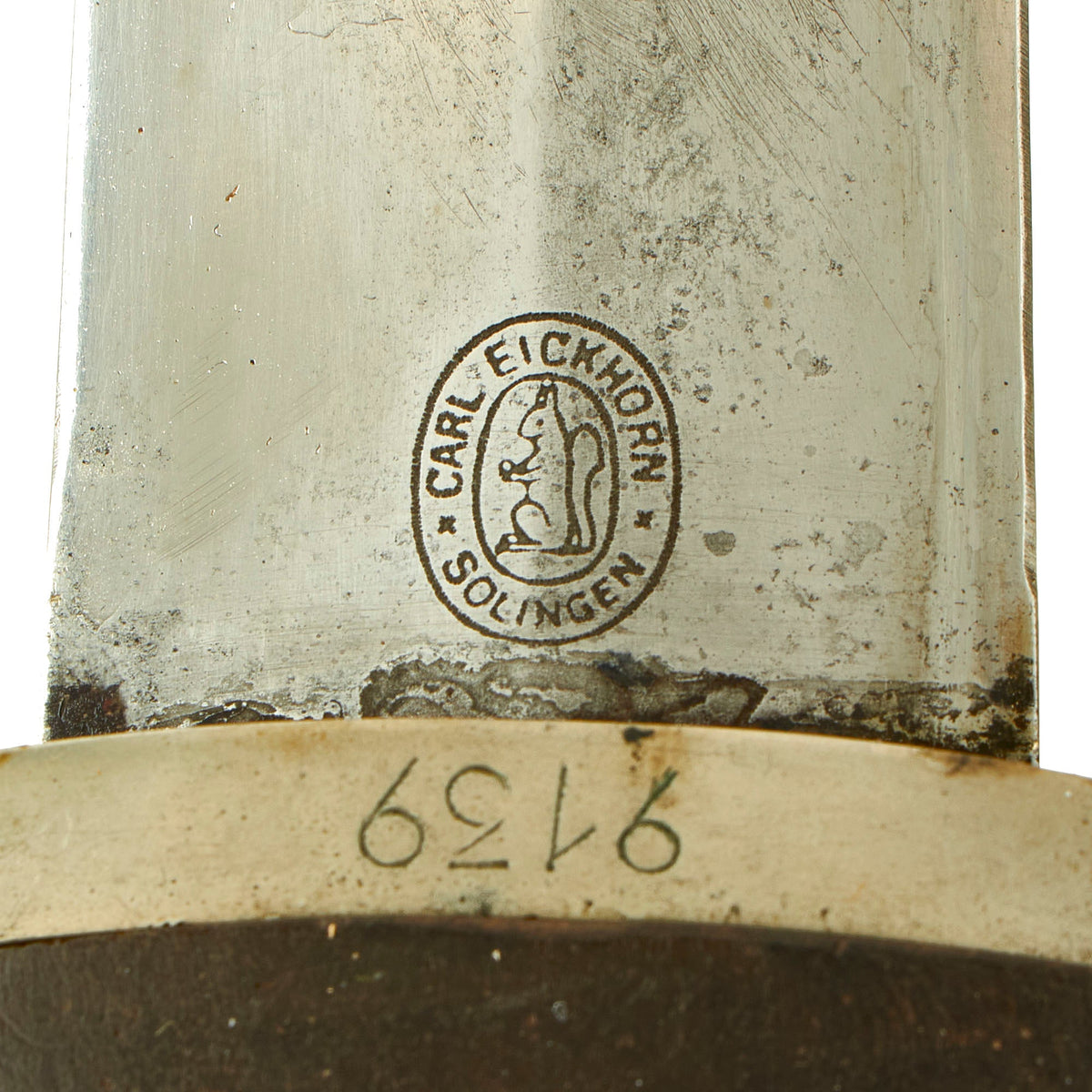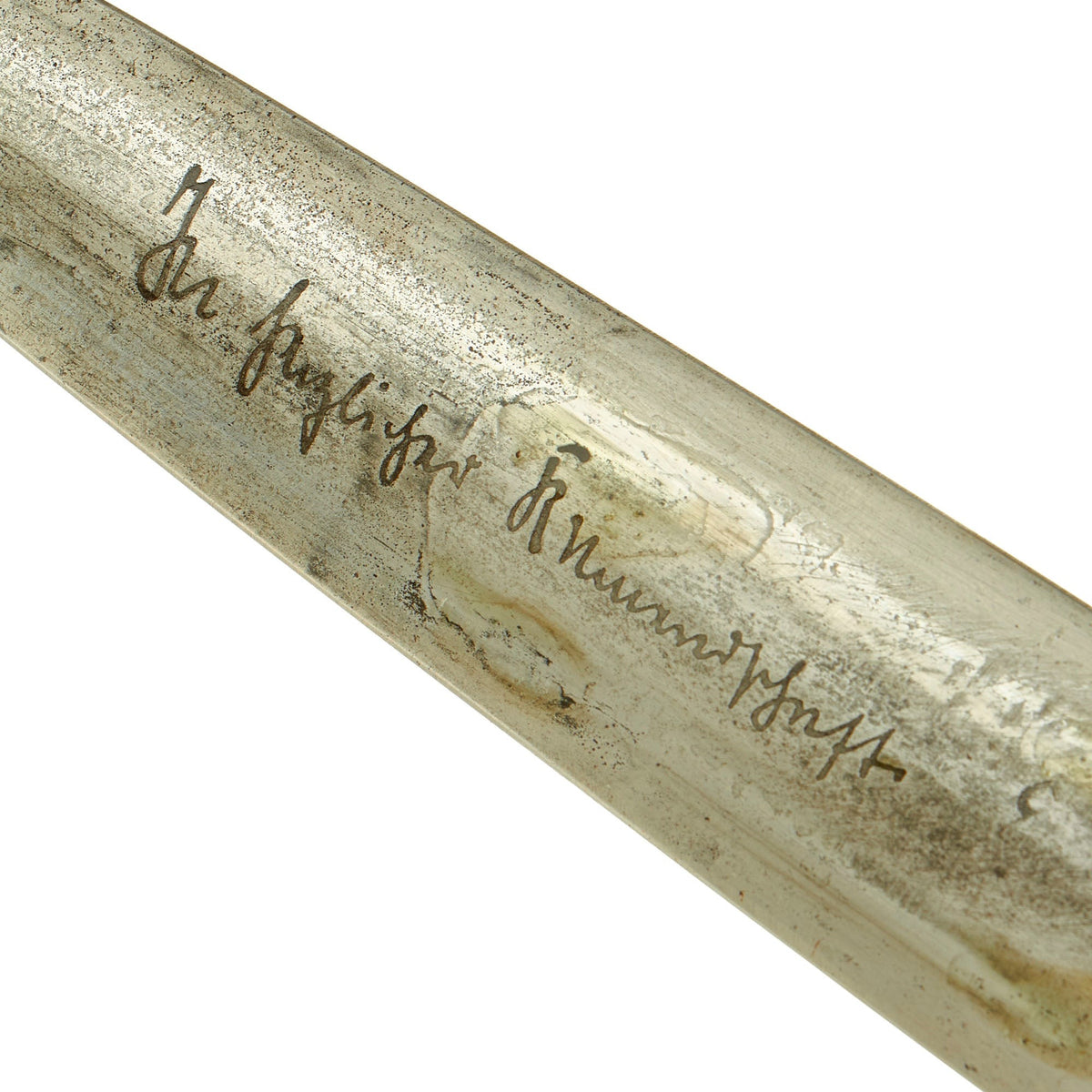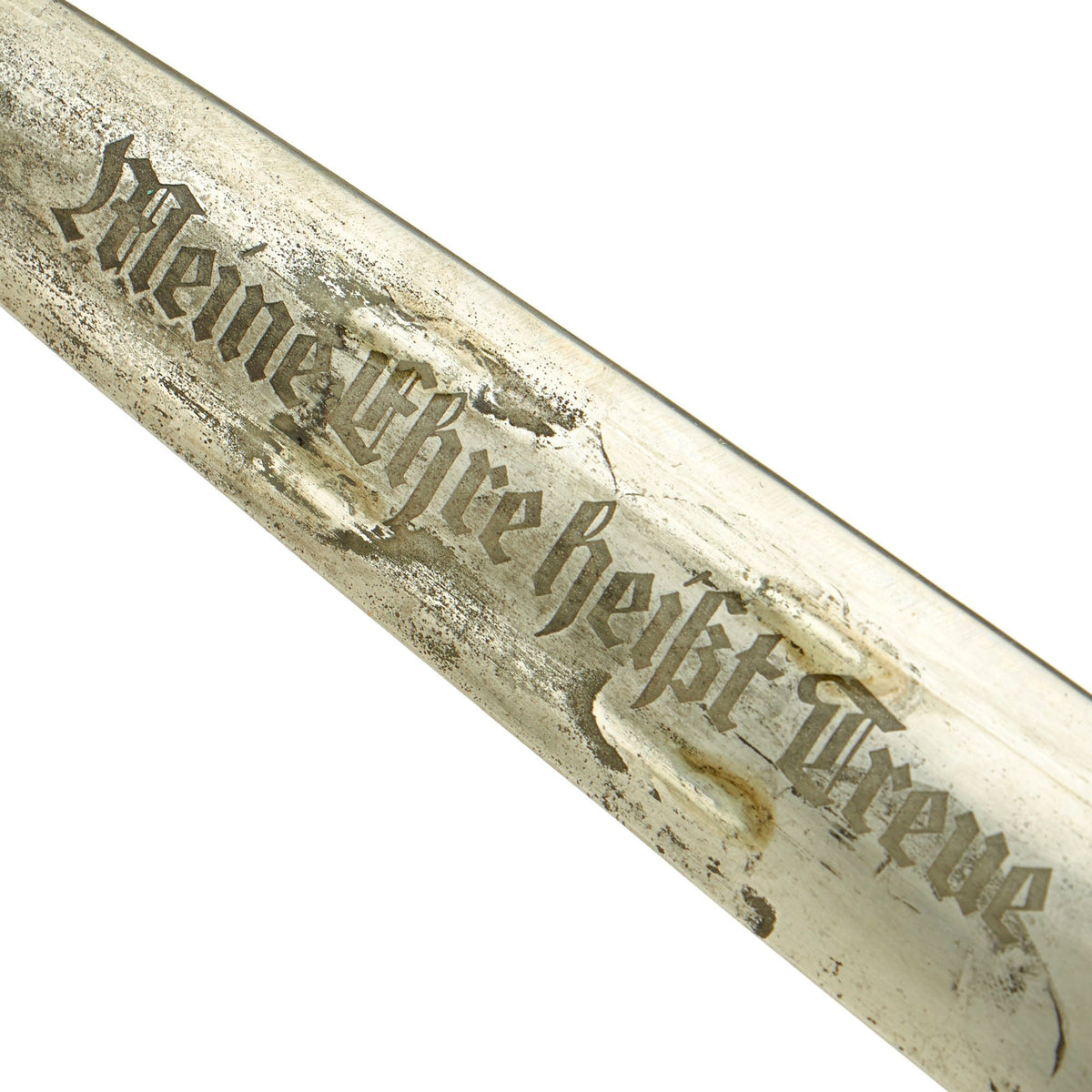Original German WWII Early Partial Ground Röhm Signature Identified Numbered M33 SS Dagger by Eickhorn with Scabbard & Rare Vertical Belt Hanger Original Items
$ 4.895,00 $ 1.223,75
Original Item: Only One Available: Prior to his “unmasking” as a traitor, Ernst Röhm was the leader of the Sturmabteilung (SA). In 1934, he distributed approximately 100,000 SA daggers with his personal inscription on the reverse blade. This was etched into the blade, and read In Herzlicher Kameradschaft Ernst Röhm (In Cordial Comradeship Ernst Röhm). These daggers were to honor individuals who had served with the SA prior to December, 1931. At this time, the Schutzstaffel (SS) was an Elite Unit within the SA, so longtime members were among those who received signed daggers as well.
Other than the inscription, these pieces were identical to the standard M1933 SS dagger. After the Röhm purge in mid 1934, the inscription was ordered to be removed, and failure to comply would be considered treason. Some were simply ground in the field by whatever means were available. Many other examples were returned to the factory for grinding and refinishing. Examples will occasionally be encountered with remnants of the original inscription remaining on the blade, but mostly none will remain. Some blades, such as this fantastic example, exist with an intact inscription, exhibiting only the removal of the Röhm signature, usually called a “Lazy Man” type. There are even still remnants of the signature! Very, very rarely is an example seen with a full, untouched inscription, as the holder would have surely risked a charge of treason.
The SS (Schutzstaffel) was originally formed in 1925, ostensibly to act as a small, loyal bodyguard unit to protect the Führer, Adolf AH. Under the direction of the Reichsführer-SS Heinrich Himmler, the SS grew to be the most ruthless and feared organization of the 20th century. They were the vanguard of the NSDAP organization, and eventually controlled nearly every function of German life and much of Occupied Europe. The SS dagger was introduced in 1933. Early on, members of the SS were awarded their daggers during a ceremony at the Feldherrnhalle Memorial in Munich. The annual ritual, charged with mysticism and meant to evoke the traditions of medieval Teutonic knights, was held on 9 November, the date of the unsuccessful Munich Putsch of 1923. Both officers and enlisted men wore the identical dagger until 1936. After this time, only enlisted men wore the M1933 dagger.
The SS Dagger was equipped with nickel crossguards with an ebony wood grip. The black grip contained a National eagle with swas insignia recessed in the center area and an SS sigrunne button inset at the top. On early examples the scabbard shell surface was factory blackened using a metal bluing process. The scabbard had nickel mounts. The SS blade was a polished type containing the SS motto, Meine Ehre Heißt Treue (My Honor is Loyalty). Early examples were mostly hand-fit. Production of later examples was more standardized, using cheaper, nickel-plated fittings with black painted scabbard shells. They could be held with a standard belt hanger, or a much rarer vertical hanger.
The blade on this example is in good condition, and like many SS daggers we see, it has evidence of past water exposure and oxidation, which has now been cleaned away, leaving some scattered pitting and staining. The factory final grind markings are really only present very close to the crossguard on both sides of the blade. This texture is iconic, and is the definitive identifying characteristic for a real WWII German Blade.
The reverse ricasso is etched with a 1933-35 Eickhorn trademark logo: a double oval surrounding a seated squirrel with a notched tail holding a sword, with CARL EICKHORN / SOLINGEN surrounding the squirrel trademark. Per J. Anthony Carter’s book GERMAN KNIFE AND SWORD MAKERS, this is one of several similar trademarks used during the period, and is exactly what would have been used on early SA, NSKK, and SS daggers signed by Röhm.
This legendary company was founded in 1865 by Carl Eickhorn, and is arguably the most famous of all Solingen makers. Not only could the family trace their history back 500 years, but they could also demonstrate involvement in the hardening and grinding industries for the same period. Truly the nobility of Solingen Edged weapon dynasties. Eickhorn edged weapons are the most desirable of all makers.
The rear of the blade also still shows a clear In Herzlicher Kameradschaft (In Cordial Comradeship) partial Röhm signature, with the factory darkening still mostly intact. There is even most of the “E” and some of the end of the signature as well, so this definitely is a “Lazy Man” removal, with no evidence it was sent back to the factory for repolishing. The acid etched SS motto on the front, Meine Ehre heißt Treue (‘My honor is loyalty’) is clear, though the factory darkening is partly worn away due to cleaning. The edge of the blade does not show any sharpening after the original factory grind, and is still in good condition.
The crossguards of this dagger and tang nut are in very good condition throughout, and are of the earliest solid nickel silver construction. They have smooth surfaces, good crisp edges and precise accent grooves. They show some light cleaning, and have only a bit of oxidation present. The cross guard is marked with SS Number 9139, with no district number that we can see. We have found an incomplete listing of these numbers, and we actually have identified the owner of this dagger!
According to our research, SS Number “9 139” was given to Rudolf Früchtl, who was born 22 March 1909. They were also given NSDAP No. 511 154, and held the rank of SS-Untersturmführer, to which they were promoted on 12 September 1937. This was a junior officer rank equivalent to a Heer Army Leutnant (2nd Lieutenant). This is really a fantastic research opportunity, as SS records are quite incomplete. It is very possible that he saw more service and promotions in records that have never been discovered.
Per customer requests, we always check the inside of the guard on these daggers, and both the cross and pommel guards are marked H and E on the inside. This marking is identical to a other known examples from this same maker. We also found that there was a bit of “padding” put inside the crossguard in the form of some small cut up pieces of an old German newspaper in “blackletter” typeface. It may have gotten loose while in service, and the paper added to avoid noise.
The ebony grip on this example is in good condition with a great color, though like many there is a a bit of chipping and cracking near the pommel guard. The treatment used on these grips makes them quite brittle, so they crack quite easily, and Ebony is also known for cracking somewhat easily, which makes this condition typical. Still. it is a lot better than many we have seen, and still has a great color. The ᛋᛋ doppelte Siegrune (Double Sig/Victory Rune) inside double circles emblem is in good condition, with partly intact enamel, though the metal portions show a lot of oxidation. The nickel grip eagle is the “high-necked” type with the beak pointing slightly up, and shows only minor wear, with oxidation in the recesses.
The scabbard shell is a good example, showing wear from age and use. There is a sizable deep dent on the front edge of the scabbard, which almost looks like a ricochet or shrapnel strike. It does not interfere with sheathing the blade. The shell originally had a black “anodized” finish, which was then lacquered to protect it. Both the lacquer and anodized finish on the dagger are almost completely worn away, and the steel body now shows a gray oxidized patina. The matching solid nickel silver scabbard mounts are in good condition. The lower ball has been dented in just a bit, which is a bit of a rarity. The weaker nickel alloy used in early models (later ones used steel) is unfortunately prone to denting. All four dome headed screws are present, and in good condition.
The scabbard is held securely in the extremely rare leather vertical hanger, topped with a plated steel hanger clip. The leather is in good condition, showing a lot of period wear and some deterioration, particularly on the buckled securing strap. The clip is marked with both the “Barred A” trademark DRGM and the (RZM) code M5 / 8, for F. W. Assmann & Söhne of Lüdenscheid, a German city known for it’s clothing accessories industry. This maker is particularly well known, and had other factories as well. These are extremely rare in any condition, but especially when they are fully intact.
An excellent chance to own a very rare “Partial Ground Röhm” early SS M33 Dagger in very nice shape, numbered to an identified SS officer and complete with the correct scabbard in a rare vertical hanger. We have never had an offering like this before, and it is unlikely we will again! Ready to research and display!
Specifications:
Blade Length: 8 3/4″
Overall length: 13 3/4”
Crossguard: 3”
Scabbard Length: 10”
Fast Shipping with Professional Packaging
Thanks to our longstanding association with UPS FedEx DHL, and other major international carriers, we are able to provide a range of shipping options. Our warehouse staff is expertly trained and will wrap your products according to our exact and precise specifications. Prior to shipping, your goods will be thoroughly examined and securely secured. We ship to thousands clients each day across multiple countries. This shows how we're dedicated to be the largest retailer on the internet. Warehouses and distribution centres can be located throughout Europe as well as the USA.
Note: Orders with more than one item will be assigned a processing date depending on the item.
Before shipping before shipping, we'll conduct a thorough inspection of the items you have ordered. Today, the majority of orders will be delivered within 48 hours. The delivery time will be between 3-7 days.
Returns
The stock is dynamic and we cannot completely manage it because multiple stakeholders are involved, including our factory and warehouse. So the actual stock may alter at any time. It's possible that you may not receive your order once the order has been made.
Our policy is valid for a period of 30 days. If you don't receive the product within 30 days, we are not able to issue a refund or an exchange.
You can only return an item if it is unused and in the same state as the day you received it. You must have the item in its original packaging.
Related products
Uncategorized
Uncategorized
Uncategorized
Uncategorized
Uncategorized
Uncategorized
Uncategorized
Uncategorized
Uncategorized
Australian WWII Owen MK1 Machine Carbine SMG Custom Fabricated Replica with Sling Original Items
Uncategorized
Uncategorized
Uncategorized
Uncategorized
Uncategorized
Uncategorized
Uncategorized
Angolan Rebel 1970s era 60mm Inert Display Mortar from Angolan Civil War Original Items
Uncategorized
Uncategorized
